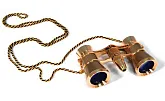Binocoli: schema di base
Binoculars are one of the most popular optical tools for studying remote objects. The first working prototype was designed by Galileo Galilei in 1608. It was his idea to combine two spotting scopes in one optical tool to create a stereoscopic image. To this day, the binoculars' general assembly diagram remains the same. However, today completely different optical schemes are used. Initially, only paired lenses (an objective and an eyepiece lens) were installed in the binoculars. Centuries later, prisms were added to decrease the size and to improve light gathering and achieve a stereo effect.
Binoculars: basic scheme and functioning
The structure and functioning of modern binoculars are based on the same elements as Galileo Galilei introduced. The optical design forms a magnified image, the shell protects the tool from negative outdoor influence; the mechanical part allows for adapting the optics to the observer’s needs. This article is devoted to the evolution of the binoculars' optical schemes.
The design Galileo invented more than 400 years ago is still used in some modern binoculars. It was a wonderful solution for its time but it soon turned out that a binoculars' scheme of Galileo's design required alteration. Yes, the binoculars were lightweight, compact and transmitted an upright, undistorted image but at more than 4x magnification the image quality suffered. That is why nowadays Galileo's design is only used in opera glasses that do not need powerful optics.
We have Ignazio Porro to thank for modern binoculars with high magnification. He invented and patented well-known Porro prisms in 1854. The first Porro binoculars, however, were designed in the late 1890s. The sunbeam changes its direction four times in Porro prisms binoculars but does not lose its intensity after all refractions. It was therefore possible to create high-aperture binoculars with Porro prisms that are great even for astronomy observations. They have only one disadvantage – their large size and weight.
Ernst Abbe and, later, Albert Koenig worked on enhancing the prism binoculars design to improve their consumer characteristics. In 1905, the Abbe-Koenig prism was patented, which became known as roof prism. The roof prism family includes the Schmidt-Pechan prism. While roof prism binoculars have a compact size and lightweight design, Porro prism models are considered better in overall optical quality. However, low-dispersive or aspheric lenses, additional optics coverings and other modern technologies used in professional roof binoculars minimize the difference between these optical designs. You can buy quality binoculars with roof prisms but they will be more expensive than a similar model based with Porro prisms.
You can acquire opera glasses with Galileo's design as well as modern binoculars with Porro or roof prisms in our online store.
È vietata qualsiasi riproduzione del materiale a scopo di pubblicazione in qualsiasi supporto informatico e in qualsiasi formato. È possibile fare riferimento a questo articolo con il link attivo su it.levenhuk.com.
Il produttore si riserva il diritto di apportare modifiche al prezzo, alla gamma di prodotti e alle specifiche o di interrompere la produzione di prodotti senza preavviso.



